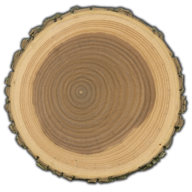...demonstrator at this month's meeting who would not wear a face shield stating that he had safety glasses with side shields and the piece was small, 1-1/2 x 1-1/2 x 9
Hmm...
A 1.5" spindle, 9" long? Think of what would happen if that broke. Better yet, try it: put on all your safety gear, spin a short spindle blank like that in a chuck, and cut it into two pieces anywhere along the length. Watch what happens to the piece cut off. Consider the physics. Even a 1" diameter piece of wood 14" long is harmless if cut or broken in two.
What about miniatures? The penny shows the scale. Would a
non-negotiable full face shield policy enforcement apply to demonstrating these?

Perhaps for some situations there might be room for common sense.

I turned two pieces of wood at a recent club demo - the exposed part of one blank was about 1-1/2" diameter by 2-1/5" long, the other was about 1/2" diameter by 3" long, both held in chucks. I didn't get any photos during the demo - these pics are from my handout document:

Is there a valid reason to wear full face protection when turning small pieces like these at a demo?
I was more likely to injure myself by accidentally slicing my finger with a razor-sharp skew.
I strongly agree a demonstrator should choose to wear protection where appropriate. For example, a large-diameter piece of wood that came apart it could easily throw a heavy chunk of wood at high velocity- a hazard to face, eyes, head. Demonstrators turning such things often choose to wear face protection. But remember, even a 6" dia bowl blank can be a hazard to an inexperienced turner who pries it off the lathe with a big catch!
Just for fun, I just now looked through photos I took at a bunch of demonstrations, some at clubs and some at regional turning symposiums. In all the photos
I could not find anyone wearing full face protection Glasses/safety glasses were universal. Has anyone ever seen Clewes turn one of his "winged bowls", basically a small bowl off-center on a flat board, scary high speed,- he wore safety glasses. No audience safety shield, but some people in the "line of fire" changed seats!

I've only been to one AAW turning symposium but didn't get any photos. Does EVERY demonstrator at EVERY symposium wear full face protection at the lathe?
I read the Sample Contract on the AAW site. I wonder if it was written by a lawyer with no woodturning experience. It appears the real purpose of this contract is stated near the bottom "
this agreement invokes your individual AAW general liability insurance coverage." Does this imply the liability insurance risks invalidation by some detail? Was the Sample Contract supplied by the insurance company? No club I've belonged to, visited, or demonstrated at used this contract.
Last time I checked I was still not a lawyer.
@Ken Vasko, your club might hire one for an opinion - perhaps a signed waver would protect from a claim.
Other sections of the contract don't make sense to me. Consider this:
"When selecting your woods,
please be aware of wood allergies. No toxic or exotic woods
may be used."
The two halves of the sentence seem contradictory: first is a
suggestion to "
please be aware" followed by the
requirement concerning what is not allowed. Search the research literature or the details in almost every species in the Wood Database, or just check this article to see how many species commonly used at demonstrations are on the list.

www.wood-database.com
Wood allergies are real - but note the statement in the Wood Database article: "
In the end, using almost any wood is a calculated risk, and the question boils down to this: how much of a potential risk am I comfortable with? 1 in 10? 1 in 1,000? 1 in 1,000,000?"
What about sanding at a demo? Power sanding is one thing, not permitted in any club I've visited. But should a demonstrator be required to wear this when hand sanding a tiny thing for 10 seconds?:

To avoid all risk, never turn on your lathe or bandsaw or use hand tools. Don't use, sell, or give anything made from wood. Drink nothing by distilled water. Never walk outside, ride a bicycle, drive a car on a road or travel by plane. Stay away from anything animal, vegetable, or mineral. Don't disagree with your spouse.
JKJ




